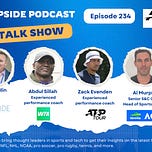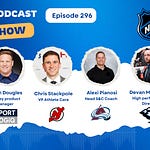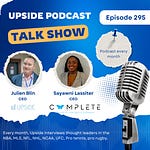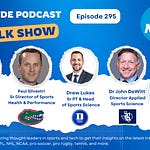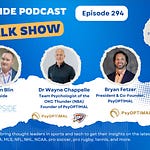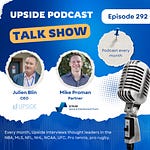This week we had the honor to interview a group of ATP/WTA sports performance experts in pro tennis.
Al Murphy, senior S&C coach at Tennis Australia. Al works with tennis players such as Rinky Hijikata, Emerson Jones and Aleks Vukic. He is also the head of sports science at Tennis Australia.
Zack Evenden, an experienced performance coach. Zack has worked with top tennis players like Frances Tiafoe, and Michael Mmoh.
Abdul Sillah, an experienced performance coach. Abdul has worked with top players such as Serena Wiliams, and Naomi Osaka.
You can read the full transcript of the podcast interview with Abdul, Zack and Al located at the top of this blog post.
Here are some of the best quotes of our conversation with them:
1. Performance Training
Q: What are key underappreciated elements in tennis training, and how has it evolved?
Zack Evenden:
“One of the things that screams out to me is how overlooked the warmup still is. I’ve seen so many players—ranked 100 to 200—just rush through it, expecting a five-minute warmup or the first few games of a match to get them ready. But when you look at the top 50 players, it’s religious. They wake up early, maybe do Pilates, then a mobility session, then warm up before practice and again before the match. It’s layered. And the warmup isn’t just about injury prevention—it’s conditioning, mental prep, prehab, even performance. Yet outside the top tier, it’s often treated like an afterthought.”
Al Murphy:
“A lot of people talk about strength training now, and that’s great because it wasn’t always mainstream in tennis. But where I think we’re still lagging is in making that training individualized and aligned with a player’s game style. If your player needs to get into specific joint positions because of how they hit or move, your training needs to reflect that. I also think we undervalue reaction time and neural processing—how the brain links to movement and spatial awareness. That stuff can be game-changing if you integrate it right.”
Abdul Sillah:
“If your warmup is done in 15 minutes, something’s wrong. You need 45 minutes to an hour minimum. Players don’t realize—rehab means something went wrong. You prevent rehab through all those 'boring' things: prehab, mobility, tissue prep. The warmup is your first defense. The elite athletes? They live in this space. It’s not optional for them.”
2. Mental Preparation
Q: What are the latest mental resilience techniques in tennis?
Abdul Sillah:
“Tennis is one of the most mentally demanding sports—90% of it is mental. I create unpredictable scenarios, like waking athletes up at 2 a.m. during camp to train. Not because I want to torture them, but because I need them to be comfortable with the unexpected. If they’ve already trained under those kinds of stressors—sleep deprivation, emotional discomfort—then when they’re down two sets or facing a hostile crowd, it’s not new. They’ve already had to find focus and composure in chaos.”
Zack Evenden:
“Mental toughness doesn’t magically show up on match day. You have to train it. That means doing things your body and brain don’t want to do, like waking up at 6 a.m. for an ice bath. When you’re down in the third set and your body is screaming to slow down, that mental conditioning kicks in. And discipline—real discipline—is doing the small, uncomfortable things every day, not just flipping a switch when the match starts.”
Al Murphy:
“We’ve built a mental skills framework that starts young—training focus, reflection, staying present. It’s about helping players reset emotionally after losses, and keeping their focus from drifting during matches. The mental game isn’t just something you tack on later. It needs to be baked into the system from the beginning.”
3. Rehabilitation
Q: What new rehab strategies or technologies are effective in tennis?
Al Murphy:
“We’re using isokinetic technology with the 1080 Motion system, which allows players to go through rehab ranges with controlled speed and resistance that they regulate themselves. That means early in rehab, we can safely work on restoring range of motion and strength without risk. On the cognitive side, we’re also using Prism Neuro to assess how well players are processing visual and spatial info—are their eyes tracking at the same speed as before the injury? Are they reacting to their environment properly? It helps us know when they’re truly ready to compete, not just physically but neurologically.”
Abdul Sillah:
“I use The Quick Board a lot—it’s all about cognitive recovery. If you can give players reaction tasks that pull their focus away from the injury and toward solving problems, you begin rewiring that fear. It’s about creating a controlled environment where they start forgetting the injury and reacting instinctively again. That’s when you know they’re on the path back.”
Zack Evenden:
“It’s not just about the exercises—it’s how the athlete perceives the work. Sometimes you have to redesign drills so they don’t feel like they’re repeating the action that caused the injury. Also, load tracking is crucial. If they feel something and panic, numbers help them stay grounded. Instead of reacting emotionally—‘oh that hurts’—you can show them, ‘you actually did more yesterday.’ It builds confidence and keeps them accountable.”
4. Load Management
Q: How do you balance recovery and performance amid grueling schedules?
Zack Evenden:
“Andy Murray told me once, ‘If I had Catapult tech earlier, I’d have five more years on my career.’ He didn’t realize the cumulative damage he was doing until it was too late. I pushed for my players to use Catapult, but it was new, and a lot of them resisted. Athletes don’t always want to change—but those who do, extend their careers.”
Al Murphy:
“We use Catapult across our academy system, even in the gym. The vest has integrated heart rate tracking and helps us look at full-day load—warmups, court time, plyos, lifting, recovery. The players wear it in training, but we can’t always get match data. So we combine that with Hawk-Eye data, HRV, and the Prism Neuro system to check real-time brain stress. Sometimes it’s not overtraining—it’s a breakup or jet lag. That data prompts important conversations.”
Abdul Sillah:
“Every morning, the first question I ask is, ‘How did you sleep?’ That tells me what kind of load they can handle that day. If they were out late for pleasure, I’m punishing them. If it was work-related, I’ll adjust training. It’s about accountability and communication.”
5. Sleep Management
Q: How do top players integrate sleep to enhance performance?
Abdul Sillah:
“I don’t care what time you went to bed. When I call you at 6 a.m., you’re up. That creates discipline. It teaches players that if they don’t manage their sleep, there’s a consequence. Every day I ask, ‘How much sleep did you get?’ And depending on whether it was for recovery or for social reasons, I’ll either adjust the plan or increase the intensity. That’s how you build maturity and accountability.”
Zack Evenden:
“Felix Auger-Aliassime always naps before matches. It’s part of his routine. Sleep in tennis isn’t just one block—it’s distributed. Players are in different time zones weekly, and their matches might be at noon one day and 10 p.m. the next. Some guys function better on 10 hours, some on 6. You have to tailor everything around the individual and constantly monitor how they’re adapting.”
Al Murphy:
“Grand Slam matches can end at 3:00 a.m. or later, but that’s not the end—it’s media, drug testing, recovery. They’re at the site till 5:00 a.m., then back the next day. You have to plan recovery windows immediately. It’s a puzzle—can we hit later tomorrow? How do we manage their load while they’re making up sleep debt? It’s chaos if you’re not ready.”
6. Innovation
Q: What technologies are shaping the future of training and recovery in tennis?
Abdul Sillah:
“Technology is great—until it makes coaches lazy. I’ve seen guys stop coaching and just start reading off data sheets. Players too—they start relying on heart rate data to tell them how they feel. But sometimes your HRV says you’re tired, and you’re actually ready. So now you’re building athletes who rely on machines instead of instincts. That’s dangerous. Use it as a tool, not a crutch.”
Zack Evenden:
“Novak Djokovic is always a step ahead with tech—he’s already tried what most players are just hearing about. That’s where the sport is going. But for me, it has to be practical. Something like the AVA cooling technology device—if it’s simple, effective, easy to use—that’s exciting. That’s what we need more of.”
Al Murphy:
“What excites me is when data confirms what elite coaches have sensed for years. Markerless tracking and ball tracking technologies give us quantifiable feedback on gut instincts—reaction time, court coverage, shot decisions. It lets great coaches fine-tune their methods and prepares us for the next evolution of the sport.”
You may also like:
🎾Upside Chat with Abdul Sillah, A World’s Class High Performance Coach For Top Athletes (Serena Williams, Naomi Osaka, Aaron Aaron Hicks / New York Yankees)
Today we have the honor to interview Abdul Sillah, a world's class high performance coach who has worked with top athletes such as top tennis players, like Serena Williams, Naomi Osaka, Sloane Stephens, Bianca Andreescu. He also worked with MLB/NFL players.
🔥 Upside Chat: Machar Reid, Innovation Lead (Tennis Australia)
This week we have the honor to interview Machar Reid, the head of Innovation of Tennis Australia who owns the Australian Open Tennis, and the new tech fund Wildcard Ventures.

